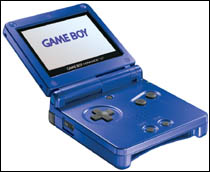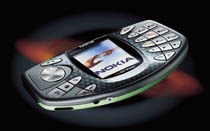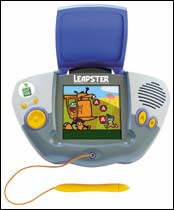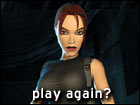
NEW YORK (CNN/Money) – When it comes to handheld gaming, Nintendo isn't just king of the hill, it owns the hill - and the 50 acres surrounding the hill.
Since the launch of its Game Boy system in 1989, no company has come close to knocking Nintendo from its perch. So powerful is its dominance that some systems, like Red Jade, were cancelled before they even made it to market. The next 18 months could see a shift in the handheld gaming space, however. Four serious competitors are looking to steal a piece of Nintendo's most lucrative market.
The biggest, of course, is Sony's PSP. Announced last week at the Electronic Entertainment Expo, this handheld device won't be released until next winter. The initials stand for "PlayStation Portable" but the PSP should do more than just play games. The inclusion of a USB 2.0 port and a slot of Sony's memory stick technology suggest it will be able to playback music files and perhaps even movies.
 |
|
| Nintendo's Game Boy Advance SP |
Sony (SNE: Research, Estimates) carefully avoided giving any pricing details on the PSP, but analyst Gary Cooper of Banc of America Securities expects it to retail for $150-$200, compared to the Game Boy Advance SP's $99 price tag. Games for the device, he said, may retail for $15-$20, which is $5-$10 lower than GBA games.
Take Two Interactive has already expressed guarded interest in the PSP, contingent on Sony's marketing plans. And it's a safe bet Electronic Arts (ERTS: Research, Estimates) is also contemplating making games for the system (likely ports of its PlayStation 1 titles). EA doesn't have a significant commitment to Nintendo's handheld. Take Two (TTWO: Research, Estimates) has none. Should the industry's top two publishers lend their weight to the PSP's game catalog, that will give Sony an incredible advantage – and give it the opportunity to topple Nintendo.
Three other handhelds will try to carve out a portion of the market before the PSP makes its run, though.
First up is Nokia's N-gage – a combination cell phone, handheld gaming device, MP3 player that goes on sale in October for $299. Games will cost $30-$40 each.
 |
|
| Nokia's N-gage |
Nokia (NOK: Research, Estimates) sunk a lot of money into promoting the N-gage at E3 – and things really couldn't have gone much worse for the company. Its press conference was embarrassing, particularly the way the company decided to announce the retail price – a model stripped off her shirt to reveal a tiny bikini and $299 written across her stomach. The games on the system simply didn't look that impressive, with a visual quality below that of the GBA. The phone's number-pad was too small to comfortably play games. And the price point of both the hardware and software was considered much too high.
"We expect Nokia's foray into handheld gaming may be brief," said Cooper in a report.
Children's educational toy maker LeapFrog (LF: Research, Estimates) is also jumping into the fray. The Leapster will launch in November, combining animated games with educational content. Targeted at children 4-8 years old, the device will retail for $80, with software going for $25.
 |
|
| LeapFrog's Leapster |
Obviously, the Leapster's market is limited and it will never take the Game Boy's place as the leading handheld gaming device. It will, though, present a strong challenge in the children's gaming market, an area Nintendo has owned exclusively for much of its history.
The device that has me the most intrigued, though, is the Helix from Tapwave. Due out in the fourth quarter of this year, the Helix offers some of the most impressive looking graphics I've seen in a handheld device – as well as wireless multiplayer gameing, PDA functionality and the ability to play audio and video files. It also fits comfortably in your hands.
Retail prices haven't been announced, though they'll likely fall in the expensive neighborhood of $300. That's a lot – maybe even too much, ultimately - but Helix comes with some street cred. It's being made by former Palm engineers and includes Palm, Yamaha, ATI and Motorola among its hardware partners.
It has fewer announced games than its competitors, but "Tony Hawk" and "Neverwinter Nights" are a good base. And expect more to be announced closer to launch, including "a first person shooter from id Software" Byron Connell, Tapwave's cofounder told me at E3.
Like the Leapster, the Helix probably won't greatly affect GBA sales. Nintendo has been trying to appeal to an older audience lately, though – specifically, with the GBA SP's sleek compact design. Helix could draw some of those potential buyers away.
Don't misunderstand. Nintendo isn't showing any signs of imminent weakness in this market. In fact, since its release in late March, the GBA SP has sold 950,000 units. And more than 143 million Game Boys have been sold in the last 14 years. At least one new version of the system is already in development, perhaps even two – though the notoriously tight-lipped company won't comment on the matter.

| |
|
Previous columns? Click Lara.
|
|
Publicly, Nintendo is putting on a brave face, with president Satoru Iwata saying "there is no need for us to be overly concerned right now". Privately, though, the company is bunkering down, preparing for what will likely be a series of initial small skirmishes, followed by a full-scale war.

Morris is Director of Content Development for CNN/Money. Click here to send him an email.
|

